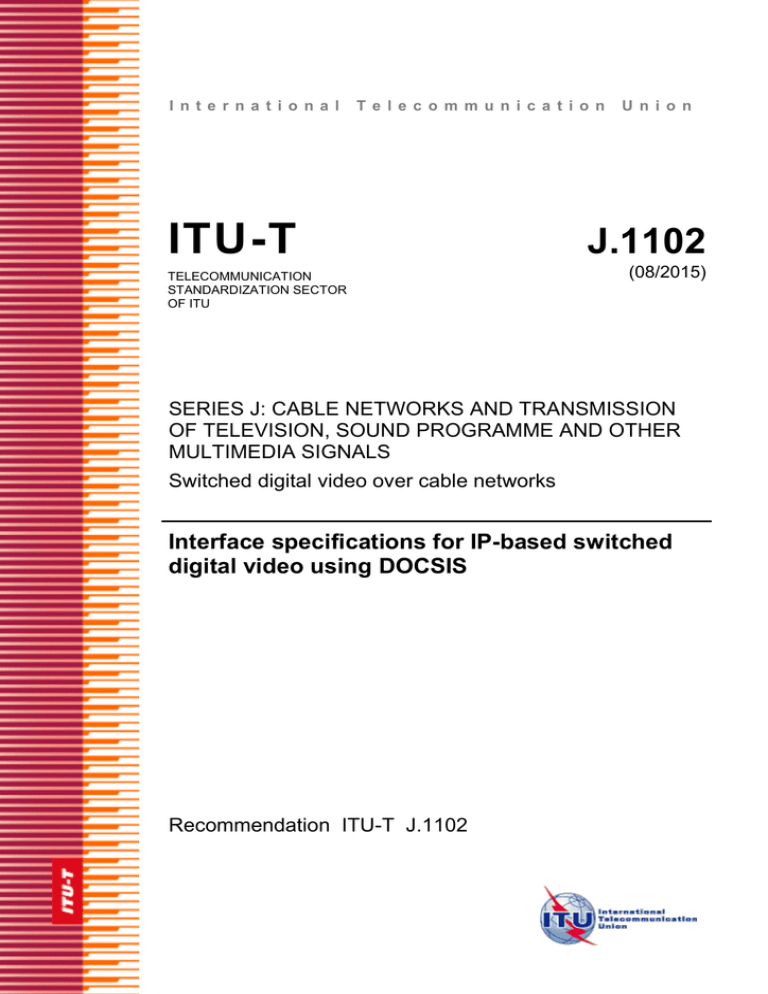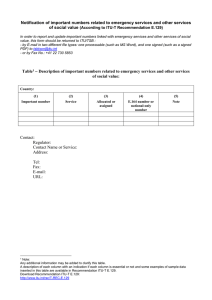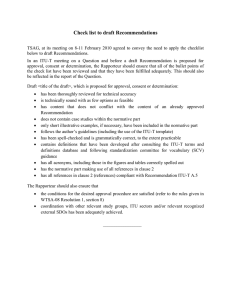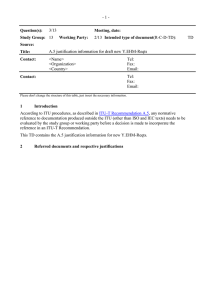
I n t e r n a t i o n a l
T e l e c o m m u n i c a t i o n
ITU-T
TELECOMMUNICATION
STANDARDIZATION SECTOR
OF ITU
U n i o n
J.1102
(08/2015)
SERIES J: CABLE NETWORKS AND TRANSMISSION
OF TELEVISION, SOUND PROGRAMME AND OTHER
MULTIMEDIA SIGNALS
Switched digital video over cable networks
Interface specifications for IP-based switched
digital video using DOCSIS
Recommendation ITU-T J.1102
Recommendation ITU-T J.1102
Interface specifications for IP-based switched digital video using DOCSIS
Summary
Recommendation ITU-T J.1102 describes the interface specifications for IP-based switched digital
video (SDV) using data over cable service interface specifications (DOCSIS) in a digital cable
network. The cable broadcasting system has been changed to use resources efficiently and to transmit
said resources in such a way that the varying needs of subscribers are easily accommodated. The
interface specifications described in this Recommendation are defined according to Recommendation
ITU-T J.1101, Functional requirements for IP-based switched digital video using data over cable
service interface specifications. These specifications are designed to maintain quality of service (QoS)
while using bandwidth effectively in a hybrid fiber/coaxial (HFC) network environment.
History
Edition Recommendation
1.0
ITU-T J.1102
Approval
Study Group
Unique ID*
2015-08-13
9
11.1002/1000/12571
____________________
*
To access the Recommendation, type the URL http://handle.itu.int/ in the address field of your web
browser, followed by the Recommendation's unique ID. For example, http://handle.itu.int/11.1002/1000/11
830-en.
Rec. ITU-T J.1102 (08/2015)
i
FOREWORD
The International Telecommunication Union (ITU) is the United Nations specialized agency in the field of
telecommunications, information and communication technologies (ICTs). The ITU Telecommunication
Standardization Sector (ITU-T) is a permanent organ of ITU. ITU-T is responsible for studying technical,
operating and tariff questions and issuing Recommendations on them with a view to standardizing
telecommunications on a worldwide basis.
The World Telecommunication Standardization Assembly (WTSA), which meets every four years, establishes
the topics for study by the ITU-T study groups which, in turn, produce Recommendations on these topics.
The approval of ITU-T Recommendations is covered by the procedure laid down in WTSA Resolution 1.
In some areas of information technology which fall within ITU-T's purview, the necessary standards are
prepared on a collaborative basis with ISO and IEC.
NOTE
In this Recommendation, the expression "Administration" is used for conciseness to indicate both a
telecommunication administration and a recognized operating agency.
Compliance with this Recommendation is voluntary. However, the Recommendation may contain certain
mandatory provisions (to ensure, e.g., interoperability or applicability) and compliance with the
Recommendation is achieved when all of these mandatory provisions are met. The words "shall" or some other
obligatory language such as "must" and the negative equivalents are used to express requirements. The use of
such words does not suggest that compliance with the Recommendation is required of any party.
INTELLECTUAL PROPERTY RIGHTS
ITU draws attention to the possibility that the practice or implementation of this Recommendation may involve
the use of a claimed Intellectual Property Right. ITU takes no position concerning the evidence, validity or
applicability of claimed Intellectual Property Rights, whether asserted by ITU members or others outside of
the Recommendation development process.
As of the date of approval of this Recommendation, ITU had not received notice of intellectual property,
protected by patents, which may be required to implement this Recommendation. However, implementers are
cautioned that this may not represent the latest information and are therefore strongly urged to consult the TSB
patent database at http://www.itu.int/ITU-T/ipr/.
ITU 2015
All rights reserved. No part of this publication may be reproduced, by any means whatsoever, without the prior
written permission of ITU.
ii
Rec. ITU-T J.1102 (08/2015)
Table of Contents
Page
1
Scope.............................................................................................................................
1
2
References.....................................................................................................................
1
3
Definitions ....................................................................................................................
3.1
Terms defined elsewhere ................................................................................
3.2
Terms defined in this Recommendation .........................................................
1
1
1
4
Abbreviations and acronyms ........................................................................................
1
5
Conventions ..................................................................................................................
3
6
IP-based SDV reference model ....................................................................................
6.1
Transmission function ....................................................................................
6.2
Subscriber function .........................................................................................
3
4
4
7
Interface structure .........................................................................................................
7.1
SDI-1 ..............................................................................................................
7.2
SDI-2 ..............................................................................................................
7.3
SDI-3 ..............................................................................................................
7.4
SCI-1...............................................................................................................
7.5
SCI-2...............................................................................................................
7.6
SCI-3...............................................................................................................
7.7
SCI-4...............................................................................................................
5
5
5
6
6
6
6
6
8
Interface specification ...................................................................................................
8.1
Session management function ........................................................................
8.2
Resource management function .....................................................................
6
6
9
Bibliography.............................................................................................................................
10
Rec. ITU-T J.1102 (08/2015)
iii
Recommendation ITU-T J.1102
Interface specifications for IP-based switched digital video using DOCSIS
1
Scope
This Recommendation defines the interface specifications of the IP-based switched digital video
(SDV) using data over cable service interface specification (DOCSIS). The interface specifications
described in this Recommendation are defined according to [ITU-T J.1101]. The interface
specifications described in this Recommendation are defined as follows:
–
management interface specification for the session management function
–
management interface specification for the resource management function.
2
References
The following ITU-T Recommendations and other references contain provisions which, through
reference in this text, constitute provisions of this Recommendation. At the time of publication, the
editions indicated were valid. All Recommendations and other references are subject to revision;
users of this Recommendation are therefore encouraged to investigate the possibility of applying the
most recent edition of the Recommendations and other references listed below. A list of the currently
valid ITU-T Recommendations is regularly published. The reference to a document within this
Recommendation does not give it, as a stand-alone document, the status of a Recommendation.
[ITU-T J.222.1]
Recommendation ITU-T J.222.1 (2007), Third-generation transmission systems
for interactive cable television services – IP cable modems: Physical layer
specification.
[ITU-T J.222.2]
Recommendation ITU-T J.222.2 (2007), Third-generation transmission systems
for interactive cable television services – IP cable modems: MAC and Upper
Layer protocols.
[ITU-T J.1101]
Recommendation ITU-T J.1101 (2012), Functional requirements for IP-based
switched digital video using data over cable service interface specifications.
3
Definitions
3.1
Terms defined elsewhere
None.
3.2
Terms defined in this Recommendation
This Recommendation defines the following term:
3.2.1 IP-based switched digital video (SDV): Service mechanism to provide interfaces and
functionalities to enable cable television system operators to offer QoS-guaranteed broadcasting and
multicasting.
4
Abbreviations and acronyms
This Recommendation uses the following abbreviations and acronyms:
CCP
Channel Charge Protocol
CM
Cable Modem
CMTS
Cable Modem Termination System
Rec. ITU-T J.1102 (08/2015)
1
CRC
Cyclic Redundancy Check
DA
Destination Address
DC
Downstream Channel
DCID
Downstream Channel Identifier
DEPI
Downstream External PHY Interface
DMPI
DOCSIS MAC-PHY Interface
DOCSIS
Data Over Cable Service Interface Specifications
DRFI
Downstream Radio Frequency Interface
DS
Downstream
DSID
Downstream Service Identifier
EH
Extended Header
EHDR
Extended MAC Header
FC
Frame Control
FEC
Forward Error Correction
FTP
File Transfer Protocol
GBE
Giga Bit Ethernet
HCS
Header Check Sequence
HFC
Hybrid Fiber/Coaxial
IGMP
Internet Group Management Protocol
IP
Internet Protocol
IPC
Inter Process Communications
LAN
Local Area Network
MAC
Media Access Control
M-CMTS
Modular Cable Modem Termination System
MDD
MAC Domain Descriptor
MIB
Management Information Base
MPEG
Moving Picture Experts Group
MSB
Most Significant Bit
NSI
Network Service Interface
PDU
Protocol Data Unit
PHY
Physical Layer
PID
Packet Identifier
QAM
Quadrature Amplitude Modulation
QoS
Quality of Service
RPC
Remote Procedure Call
SA
Source Address
SCI
IP-based SDV Control Interface
2
Rec. ITU-T J.1102 (08/2015)
SDI
IP-based SDV Data Interface
SDV
Switched Digital Video
SF
Service Flow
SFID
Service Flow Identifier
SID
Service Identifier
SIP
Session Initiation Protocol
STB
Set-Top Box
VSI
Video Service Interface
5
Conventions
In this Recommendation:
The keywords "is required to" indicate a requirement which must be strictly followed and from
which no deviation is permitted if conformance to this document is to be claimed.
The keywords "is recommended" indicate a requirement which is recommended but which is not
absolutely required. Thus this requirement need not be present to claim conformance.
The keywords "is prohibited from" indicate a requirement which must be strictly followed and from
which no deviation is permitted if conformance to this document is to be claimed.
The keywords "can optionally" indicate an optional requirement which is permissible, without
implying any sense of being recommended. This term is not intended to imply that the vendor's
implementation must provide the option and the feature can be optionally enabled by the network
operator/service provider. Rather, it means the vendor may optionally provide the feature and still
claim conformance with the specification.
In the body of this Recommendation and its annexes, the words shall, shall not, should, and may
sometimes appear, in which case they are to be interpreted, respectively, as is required to, is
prohibited from, is recommended, and can optionally. The appearance of such phrases or keywords
in an appendix or in material explicitly marked as informative are to be interpreted as having no
normative intent.
6
IP-based SDV reference model
As shown in Figure 1, functionally IP-based SDV using the DOCSIS system can be categorized into
three parts:
–
the transmission function
–
the subscriber function
–
the control function.
Rec. ITU-T J.1102 (08/2015)
3
Figure 1 – Diagram of an IP-based switched digital video system
6.1
Transmission function
The transmission function processes the DOCSIS frame header and transmits it to the multicast
service group. The transmission function consists of an SDV transmission function and a downstream
PHY function. The SDV transmission function processes service flow and packet header processing
on the DOCSIS MAC layer [ITU-T J.222.2]. The downstream PHY function transmits the DOCSIS
header processed video stream to the subscriber.
6.1.1
SDV transmission function
The SDV transmission function processes service flow and does packet header processing on the
DOCSIS MAC layer.
6.1.2
Downstream PHY function
The downstream PHY [ITU-T J.222.1] function transmits the DOCSIS header processed video stream
to the subscriber.
6.2
Subscriber function
The subscriber function processes the video data stream from the transmission function. The
subscriber function consists of the SDV client service function and SDV receiver function. The
subscriber function also sends request information of an SDV video service programme to the control
function.
6.2.1
SDV client function
The SDV client function recovers an IP-based received video data stream from an MPEG-2 based
video stream and outputs it to the set-top box (STB).
6.2.2
SDV receiver function
The SDV receiver function processes physical signal processing; it is a function of the DOCSIS cable
modem.
4
Rec. ITU-T J.1102 (08/2015)
7
Interface structure
IP-based SDV system is required to consist of IP-based SDV data interface (SDI) and IP-based SDV
control interface (SCI). The SDI-1 provides the interface between the IP-based SDV transmission
module and head-end local network. The SDI-2 provides the interface between MAC and PHY in the
IP-based SDV transmission module. The SDI-3 provides the interface between the IP-based SDV
transmission module and the modular cable modem termination system (M-CMTS). The SCI-1
provides the interface between the set-top box (STB) and the session management server. The SCI-2
provides the interface between the session management server and the resource management server.
The SCI-3 provides the interface between the resource management server and the M-CMTS. The
SCI-4 provides the interface between the M-CMTS and the IP-based SDV transmission module. The
interface structure of the IP-based SDV is shown in Figure 2.
Figure 2 – The interface structure of IP-based SDV
7.1
SDI-1
The SDI-1 is defined as the interface specification between the SDV transmission module and the
headend local network system. The SDI-1 is recommended to transmit the IP-based video data stream
of the backbone network or local area network (LAN) to the IP-based transmission module. The
headend local network system is recommended to connect the session and resource management
server using IP protocol. The headend local system is recommended to connect the control and
management of the SDV transmission module using IP protocol.
7.2
SDI-2
The SDI-2 is defined as the internal interface specification between the MAC and the PHY
submodules in the SDV transmission module. The SDI-2 is recommended to connect between the
MAC function submodule and the downstream PHY submodule. The SDI-2 is recommended to
transmit the DOCSIS MAC frame which is created in the SDV transmission module to the frequency
channel using the downstream PHY submodule.
The transmission of the DOCSIS MAC frame to the downstream PHY submodule is recommended
to support three formats as follows:
–
DOCSIS MAC over MPEG-2 TS
–
DOCSIS MAC over MPEG-2 TS over IP
Rec. ITU-T J.1102 (08/2015)
5
–
DOCSIS MAC over IP
7.3
SDI-3
The SDI-3 is defined as the interface specification between the M-CMTS and the SDV transmission
module.
The SDI-3 consists of two interfaces as follows:
–
Downstream MAC/PHY interface
–
Upstream MAC/PHY interface
The SDI-3 is recommended to transmit the DOCSIS MAC frame to the downstream PHY
transmission submodule of the SDV transmission module.
The SDI-3 is recommended to transmit the information of the upstream burst stream to the MAC
submodule.
7.4
SCI-1
The SCI-1 is defined as the control interface specification between the STB and the session
management server.
The SCI-1 is recommended to obtain the information of the programme channel and the IP group
address.
7.5
SCI-2
The SCI-2 is defined as the control interface between the session management server and the resource
management server.
The SCI-2 is recommended to reserve the frequency channel resource.
The SCI-2 is recommended to transmit the information of the transmission frequency and QoS.
7.6
SCI-3
The SCI-3 is defined as the control interface between the resource management server and the
M-CMTS.
The SCI-3 is recommended to manage the frequency channel resource.
7.7
SCI-4
The SCI-4 is defined as the control interface between the M-CMTS and the SDV transmission
module.
The SCI-4 is recommended to transmit and receive the control message using IP protocol.
8
Interface specification
8.1
Session management function
The session management function is required to receive the request of the programme service and to
set the path for the transmission of video streaming. The session management function consists of the
following:
–
Session protocol processing
–
Session information management
–
Resource management interface
–
Programme information table management
6
Rec. ITU-T J.1102 (08/2015)
8.1.1
Session protocol processing
Session protocol processing is required to transmit and receive the relevant protocol unit in
accordance with session initiation protocol (SIP)/channel change protocol (CCP). Figure 3 shows the
programme select protocol transmitted and received between the session management server and
subscribers.
Figure 3 – The programme select protocol
Table 1 shows the syntax of an SDV channel change protocol message.
Table 1 – Syntax of an SDV channel change protocol message
SDV_Channel_Change_Protocol_Message() {
DSMCC_Message_Header
Message_Payload
}
Table 2 shows the syntax of a session set-up protocol message.
Table 2 – Syntax of a session set-up protocol message
Session_Setup_Protocol_Message() {
DSMCC_Message_Header
Message_Payload
}
Rec. ITU-T J.1102 (08/2015)
7
Table 3 shows the syntax of a DSMCC message header.
Table 3 – Syntax of a DSMCC message header
DSMCC_Message_Header() {
ProtocolDiscriminator
DSMCC_Type
MessageID
TransactionID
reserved
Adaptation_Length
Message_Length
if(adaptationLength>0) {
DSMCC_Adaptation_Header() {
}
}
1
1
2
4
1
1
2
byte
byte
bytes
bytes
byte
byte
bytes
Table 4 shows and describes message IDs and message names.
Table 4 – Message ID type
MessageID
Message name
Description
0x0000
Reserved
ISO/IEC 13818-6 reserved
0x0001
SDV_Program_Select_Request
Sent from a user to the SDB server to request that
a broadcast programme be provided
0x0002
SDV_Program_Select_Confirm
Sent from the SDB server to a user in response to
the SDBProgramSelectRequest
0x0003
SDV_Program_Select_Indication
Sent from the SDB server to a user to indicate
that a new broadcast programme will be provided
0x0004
SDV_Program_Select_Response
Sent from a user to the SDB server in response to
the SDBProgramSelect indication message
0x0005~0x7FFF
Reserved
ISO/IEC 13818-6 reserved
0x8000~0xFFFF
User defined
User defined SDB message
Table 5 shows and describes programme ID types.
Table 5 – Programme ID type
Broadcast ProgramID
Description
NoProgram
Identifies that a broadcast programme
has not been selected or indicated
0x00000001 ~ 0x7FFFFFFF
Broadcast Program Numbers
Uniquely identifies a single broadcast
programme
0x80000000 ~ 0xFFFFFFFF
User defined
User defined special purpose SDB
broadcast ProgramIDs
0x00000000
8
Broadcast programme
name
Rec. ITU-T J.1102 (08/2015)
8.1.2
Session information management
Session information management is required to set up the multicast session and respond to the IP
group address on the session.
8.1.3
Resource management interface
The resource management interface is required to transmit and receive data between session
management and resource management.
8.1.4
Programme information table management
Programme information table management is required to operate the programme information table.
Programme information table management is required to update the information table whenever there
are any changes on the multicast session.
8.2
Resource management function
The resource management function is required to manage the frequency channel resources in charge
of transmission in the HFC network.
The resource management function is required to satisfy the QoS standards and operate available
channel resource information.
The resource management function consists of the following:
–
resource protocol processing
–
resource information management
–
session management interface
8.2.1
Resource protocol processing
Resource protocol processing is required to allocate the frequency channel resource.
8.2.2
Resource information management
Resource information management is required to manage the frequency channel resources.
8.2.3
Session management interface
The session management interface is required to create and transmit the protocol units for the interface
between session management and resource management.
Rec. ITU-T J.1102 (08/2015)
9
Bibliography
[b-ITU-T J.112 Annex B]
Recommendation ITU-T J.112 Annex B (2004), Data-over-cable
service interface specifications: Radio-frequency interface
specification.
[b-ITU-T J.210]
Recommendation ITU-T J.210 (2006), Downstream RF interface
for cable modem termination systems.
[b-ANSI/SCTE 133]
ANSI/SCTE 133 (2010), Downstream RF interface for Cable
Modem Termination Systems.
[b-ANSI/SCTE 135-1]
ANSI/SCTE 135-1 (2013), DOCSIS 3.0 Part 1: Physical Layer
Specification.
[b-ANSI/SCTE 135-2]
ANSI/SCTE 135-2 (2013), DOCSIS 3.0 Part 2: MAC and Upper
Layer Protocols.
[b-ANSI/SCTE 135-4]
ANSI/SCTE 135-4 (2013), DOCSIS 3.0 Part 4: Operations
Support Systems Interface.
[b-ANSI/SCTE 135-5]
ANSI/SCTE 135-5 (2009), DOCSIS 3.0 Part 5: Cable Modem to
Customer Premise Equipment Interface.
[b-ANSI/SCTE 137-1]
ANSI/SCTE 137-1 (2010), Modular Headend Architecture Part 1:
DOCSIS Timing Interface.
[b-ANSI/SCTE 137-2]
ANSI/SCTE 137-2 (2010), Modular Headend Architecture Part 2:
M-CMTS Downstream External PHY Interface.
[b-ANSI/SCTE 137-3]
ANSI/SCTE 137-3 (2010), Modular Headend Architecture Part 3:
M-CMTS Operations Support System Interface.
[b-ANSI/SCTE 137-4]
ANSI/SCTE 137-4 (2010), Modular Headend Architecture Part 4:
Edge Resource Manager Interface for Modular Cable Modem
Termination Systems.
[b-ANSI/SCTE 137-5]
ANSI/SCTE 137-5 (2010), Modular Headend Architecture Part 5:
Edge QAM Provisioning and Management Interface.
10
Rec. ITU-T J.1102 (08/2015)
SERIES OF ITU-T RECOMMENDATIONS
Series A
Organization of the work of ITU-T
Series D
General tariff principles
Series E
Overall network operation, telephone service, service operation and human factors
Series F
Non-telephone telecommunication services
Series G
Transmission systems and media, digital systems and networks
Series H
Audiovisual and multimedia systems
Series I
Integrated services digital network
Series J
Cable networks and transmission of television, sound programme and other
multimedia signals
Series K
Protection against interference
Series L
Environment and ICTs, climate change, e-waste, energy efficiency; construction, installation
and protection of cables and other elements of outside plant
Series M
Telecommunication management, including TMN and network maintenance
Series N
Maintenance: international sound programme and television transmission circuits
Series O
Specifications of measuring equipment
Series P
Terminals and subjective and objective assessment methods
Series Q
Switching and signalling
Series R
Telegraph transmission
Series S
Telegraph services terminal equipment
Series T
Terminals for telematic services
Series U
Telegraph switching
Series V
Data communication over the telephone network
Series X
Data networks, open system communications and security
Series Y
Global information infrastructure, Internet protocol aspects and next-generation networks
Series Z
Languages and general software aspects for telecommunication systems
Printed in Switzerland
Geneva, 2015



